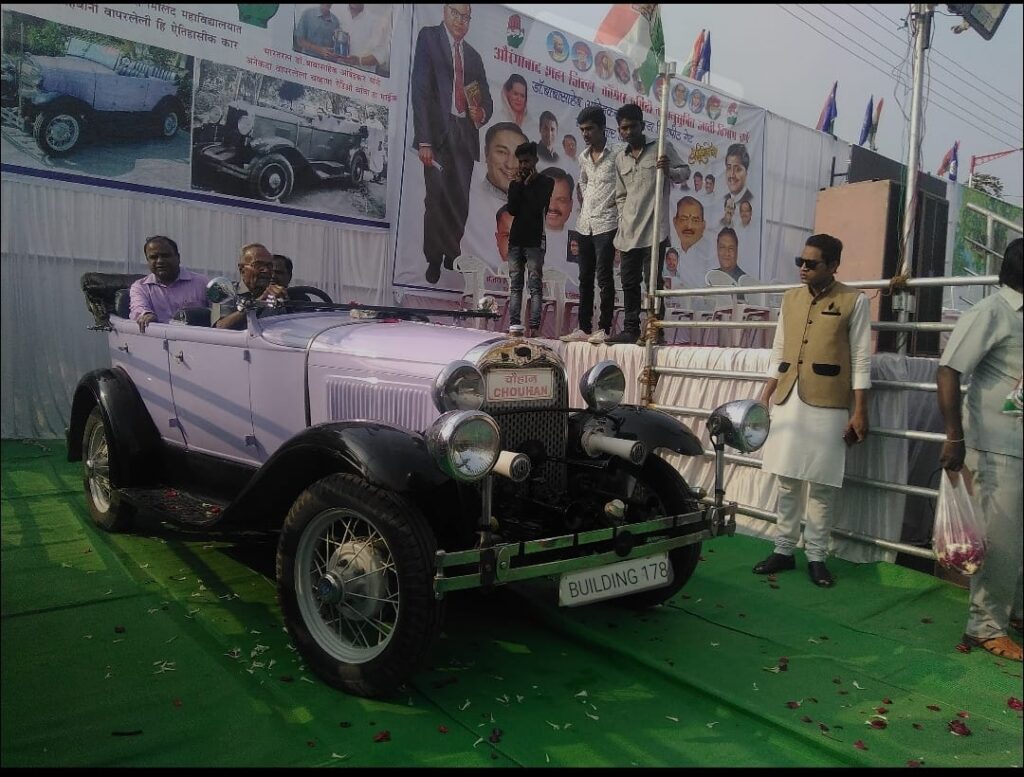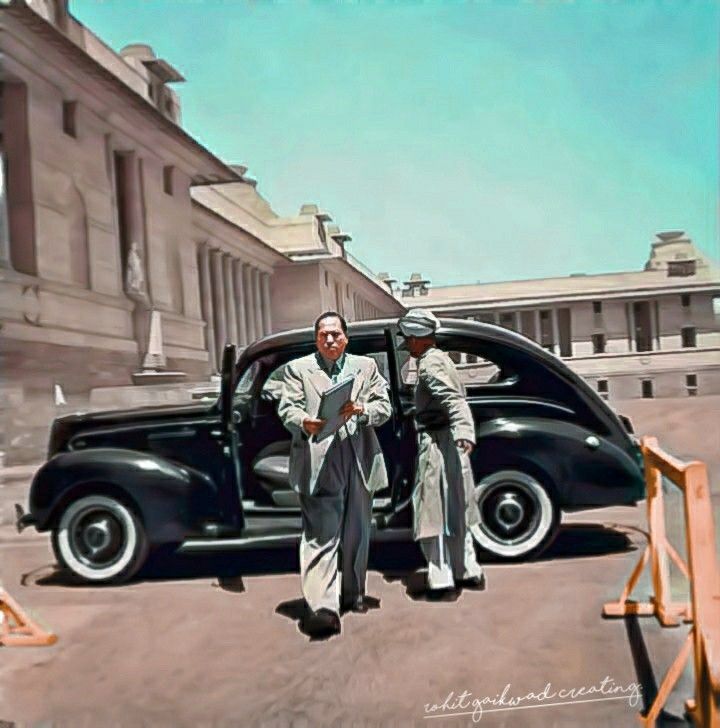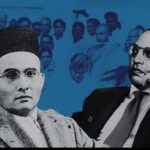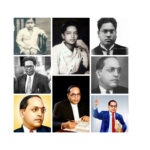The Wheels of Jay Bhim
Picture a dusty Mumbai road, a Jay Bhim flag fluttering, and a car carrying Dr. B.R. Ambedkar—Babasaheb—speeding toward a rally for Dalit rights. Dr. Babasaheb Ambedkar car collection sparks curiosity, but it’s more than metal and wheels. It’s a symbol of his journey from a Mahar Dalit boy to the architect of India’s 1949 Constitution.
Dr. Babasaheb Ambedkar’s cars were not just vehicles- they were symbols of his relentless journey toward justice, equality, and empowerment. Whether navigating the streets of Bombay as a young lawyer or traveling to Parliament in Delhi, Ambedkar’s cars carried more than just a passenger; they carried the hopes of millions.
What car did he drive? Why does it matter?
Who Was Dr. B.R. Ambedkar?
Born in 1891 in Mhow, Madhya Pradesh, Ambedkar faced caste’s cruelty as a Mahar Dalit. With a Ph.D. from Columbia and law degrees from London, he led the 1927 Mahad Satyagraha, wrote Annihilation of Caste (1936), and shaped India’s Constitution, banning untouchability (Article 17, 1949). His 1956 Buddhist conversion with 500,000 followers—80% of Maharashtra Dalits are Buddhist (2011 Census)—ignited Jay Bhim. “I like liberty, equality, fraternity,” he said. In 2025, 5 lakh visit Chaitya Bhoomi yearly (2024), honoring his fight.
Ambedkar’s life was a hustle—traveling for rallies, meetings, and reforms. Cars, though rare, were his tools. But records of his Dr. Babasaheb Ambedkar car collection are scarce. Let’s dig into what we know.
Ambedkar and His Car Collection
While Ambedkar was not known for a lavish lifestyle, he did own two notable cars during his lifetime. These vehicles were more than just modes of transport- they played a practical role in his busy schedule as a lawyer, legislator, and social reformer.
- First Car in Bombay: Ambedkar’s first car was used during his early years in Bombay (now Mumbai) to attend court sessions and legislative meetings. This car was essential for his legal practice and public engagements, offering him the mobility and independence that were rare for most Indians at the time, especially those from marginalized communities.
- Second Car in Delhi: His second car was an old model purchased from Rafi Ahmed Kidwai, a prominent freedom fighter and politician. Ambedkar used this car extensively in Delhi to attend parliamentary sessions and visit the Ashok Buddha Vihar. Notably, the Scheduled Castes Federation (SCF) flag would always flutter on its bonnet, making a powerful statement about representation and pride.
These cars were not just personal assets- they were extensions of Ambedkar’s mission, helping him reach people, places, and platforms where he could advocate for social change.
A Historic Journey: The Car in Aurangabad
One of the cars used by Dr. Ambedkar holds historical significance. During a visit to Aurangabad, Ambedkar traveled from the railway station to Milind College in his car. This journey is commemorated as a moment of pride and inspiration, especially for the Dalit community, as it symbolized mobility, dignity, and the breaking of social barriers.
“This is the historic car used by Dr. Babasaheb Ambedkar. When Ambedkar once visited Aurangabad, he traveled by the car from the station to the Milind College.”

Photographs and preserved models of Ambedkar’s car are still displayed at museums and memorials, serving as reminders of his enduring legacy.
Did Ambedkar Own a Car?
Dr. Babasaheb Ambedkar car collection sounds grand, but evidence is limited. Cars were a luxury in colonial India—only 48,000 vehicles existed by 1947 (RTO archives). As a Dalit leader, Ambedkar faced financial struggles, yet his roles as a lawyer, minister, and activist suggest he used cars.
- Bombay Life: In Mumbai, his home, Rajgriha (1934), housed his library. Traveling to rallies like Mahad (1927) or Kalaram Temple (1930), 100-200 km away, needed transport. Supporters or organizers often arranged cars, likely Fiats or Morris, popular in 1930s Bombay (auto archives).
- Contextual Clues: In 1942, as Labour Minister in Delhi, Ambedkar moved to 22, Prithvi Raj Marg, a grand house for his 50,000-book library (Rattu, 2017). A car was likely provided by the British Viceroy’s Council for official duties. By 1947, as India’s first Law Minister, he’d have used government cars—possibly a Hindustan 10, a common official vehicle (vintage car records).
- No Clear Records: Unlike his books or pens—Parker, Sheaffer, and a golden pen from England (Rattu, 2017)—no specific car model is documented. A 2022 post on brambedkar.in mentions “Babasaheb’s car collections” but lacks details.
“Ambedkar’s car was less about ownership, more about access,” says historian Ashok Gopal (2023). He likely used borrowed or official vehicles, not a personal car collection.
The Symbolic Power of Ambedkar’s Car
Why care about Dr. Babasaheb Ambedkar car collection? Cars were more than transport—they were defiance. In a casteist India, where Dalits were barred from public spaces, a car carrying Ambedkar to a rally was a bold statement. Here’s why it mattered:
- Breaking Barriers: In 1927, during the Mahad Satyagraha, Ambedkar led Dalits to drink from Chavdar Lake, 150 km from Mumbai. A car—likely a supporter’s Fiat—carried him, signaling dignity. “A Dalit in a car was revolutionary,” says scholar Aakash Singh Rathore (2023).
- Rallying the Masses: Ambedkar’s travels for the 1930 Kalaram Temple movement or the 1932 Poona Pact talks needed speed. Cars let him reach thousands, spreading “Educate, Agitate, Organize.” By 1956, 500,000 joined his Buddhist conversion in Nagpur—a car got him there.
- Status Symbol: In 1940s Delhi, ministers used cars like the Hindustan 10 (1940s auto records). Ambedkar, a Dalit, in a government car, challenged caste norms. “It was a visual of equality,” says activist Medha Patkar (2024).
In 2025, car stickers of Ambedkar, sold on Amazon for adorning vehicles, will echo his wheels of change.
Myths and Misconceptions
The idea of a Dr. Babasaheb Ambedkar car collection sparks myths. Let’s clear them:
- Myth: He Owned Many Cars. Social media, like a 2022 brambedkar.in post, hints at a “collection.” But Ambedkar’s modest life, focused on books, not luxury, makes this unlikely. His 50,000-book library, not cars, was his pride (Rattu, 2017).
- Myth: He Drove Flashy Cars. X posts (2024) imagine him in Rolls-Royces. Nope—1940s India had basic Fiats, Morrises, or Hindustans. Official cars were functional, not flashy.
- Truth: Cars Were Tools. Ambedkar used cars for work—rallies, Delhi duties, or Bombay meets. “He cared for justice, not joyrides,” says historian Ramachandra Guha on X (2024).
In 2025, caste attacks (2023) remind us: Ambedkar’s real ride was his fight for equality, not a garage of cars.
Ambedkar’s Lifestyle: Beyond Cars
To understand Dr. Babasaheb Ambedkar car collection, look at his life. Cars were practical, not passions. His true loves? Books, pens, and justice.
- Books Over Wheels: His Rajgriha home (1934) and Delhi house (1942) were built for 50,000 books, India’s largest private library (Rattu, 2017). He said,
- Simple Living: Ambedkar ate frugally—chapati, dal, veggies, sometimes chicken (Rattu, 2017). His clothes? Dhoti-kurta in summer, wool coat in winter. Cars were for work, not show.
- Pen Passion: He loved fountain pens—Parker, Sheaffer, and a golden one from England (Rattu, 2017). These, not cars, were his treasures.
“Ambedkar’s car was a means, not an end,” says scholar Anupama Rao (2024). His real drive was the Constitution, not a car collection.
Case Study: Ambedkar’s Delhi Move (1942)
In 1942, Ambedkar joined the Viceroy’s Council as Labour Minister, moving to Delhi’s 22, Prithvi Raj Marg. The house, called “haunted” by locals, was chosen by him. He transformed it with flower rows, drawing visitors (Rattu, 2017). A government car—likely a Hindustan 10 or Morris—came with the job, ferrying him to meetings. This car wasn’t his but symbolized his rise: a Dalit minister in a colonial vehicle, defying caste.
Why This Matters in 2025
Why obsess over Dr. Babasaheb Ambedkar car collection? In 2025, India faces caste attacks and a 20% rural dropouts (2024). Ambedkar’s car—real or borrowed—was a chariot of justice. It took him to Mahad, Nagpur, and Delhi, spreading “Educate, Agitate, Organize.” Today, Ambedkar car stickers on Amazon. and statues—like Vijayawada’s 125-foot “Statue of Social Justice” (2024)—keep his spirit alive.
“His car wasn’t wealth; it was will,” says Kancha Ilaiah Shepherd on X (2024). In a nation of 93% informal workers (2017), Ambedkar’s wheels remind us: move forward, fight bias.
How to Honor Ambedkar’s Legacy
Don’t just read—ride his vision:
- Read: Grab Annihilation of Caste. or The Problem of the Rupee. His words fuel Jay Bhim.
- Visit: See Chaitya Bhoomi or Mhow’s memorial—5 lakh did in 2024. Feel his fire.
- Act: Tutor a kid, fight caste. It’s Ambedkar’s way.
- Share: Post his quote.
“Ambedkar’s car carried justice,” says Medha Patkar (2024). Drive his dream.
Conclusion: Wheels of Change
Dr. Babasaheb Ambedkar car collection may be a myth—no grand garage, just practical wheels. Fiats, Morrises, or a Hindustan 10 carried him to Mahad (1927), Delhi (1942), and Nagpur (1956), fueling his fight for equality. In a casteist India, his car—borrowed or official—was defiance, a Dalit leader rolling past barriers. In 2025, with 5 lakh at Chaitya Bhoomi (2024) and 15 caste attacks (2023), his Jay Bhim legacy roars louder than any engine. His true ride? The Constitution lifted millions. On Ambedkar Jayanti, April 14, chant Jay Bhim, read Annihilation of Caste, and ask: “How will I drive justice?” Stick Ambedkar stickers and decals, share on X @Jaybhimworld, and keep his wheels turning. Babasaheb’s car wasn’t luxury—it was liberty.
Call-To-Action
- Engage: “What does Ambedkar’s car mean to you? Comment!”








